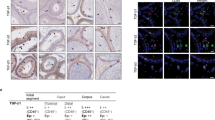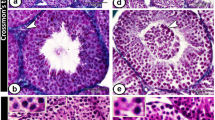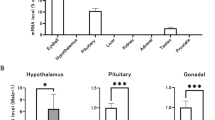Abstract
Epidermal growth factor (EGF) is produced primarily by Leydig cells of human testis. Expression of the EGF gene was assessed in mouse testis during the course of sexual maturation by the application of the RT-PCR method and the use of specific oligonucleotide primers. Testis EGF mRNA content increased with the developmental age of the mice, i.e., day 15 < day 30 < day 45 postnatal. The expression of the EGF gene appears to correlate with maturation of the testis and proliferation of Leydig cells.
Similar content being viewed by others
Introduction
Epidermal growth factor (EGF) was initially isolated and purified from the sub-maxillary gland (SMG) of male mouse1. It is a polypeptide composed of 53 amino acid residues2. It influences cell proliferation and differentiation and modulates the growth and development of mammalian organs3, 4, 5, 6, 7. A noteworthy finding is that extirpation of mouse SMG results in a marked reduction of serum EGF concentration associated with an impaired spermatogenesis3. This finding suggests that EGF may regulate sperm production and differentiation. In human testis, EGF is produced primarily by Leydig cells, as determined by an immunocytochemical technique8. The present study was performed to verify that the EGF gene is expressed in mouse testis by the application of the sensitive RT-PCR technique. Evidence is presented demonstrating that EGF gene is expressed in mouse testis during sexual maturation.
Materials and Methods
Molecular size marks
Polynucleotide molecular size markers, Hid III-treated λ DNA molecular size markes.
Animals
Guidelines for the Care and Use of Animals appoved by the Laboratory Animal House, Shanghai Institute of Cell Biology, Shanghai, China, were followed. Male Balb/c mice of days 15, 30, 45 postnatal (PN) on were obtained from the Animal House of the Shanghai Institute of Cell Biology. All animals were killed with the use of cervical dislocation. The testis and SMG were excised and processed immediately.
Synthesis of specific primers
The following oligonucleotides corresponding to the N- and C-termini of EGF were prepared by the Synthesis Facility of the Institute: sense primer, 5′-GAATTCAGTTGCCCTGACTCTACCGC3′ (nucleotides 3222 -3242) and the antisense primer, 5′GAATTCGCAGACAGCCACCATGAT-3′ (nucleotides 3467 -3488). Both primers contained an EcoRI cleavage site.
RNA isolation
A sample of 50 μg of testis or SMG (wet weight) was homogenized in 500 μ1 of denaturing solution (4 M guanidinium isothiocyanate, 20 mM Sodium acetate, pH 5.2, 0.1 mM dithiothreitol and 0.5% Sarkosyl). Total RNA was isolated by guanidenium thiocyanate/phenol-chloroform extraction method according to Kingston et al9. RNA was determined using the Gene Quant (pharmacia Biotech). The absorbance of the RNA solutions were measured at 260 and 280 nm and the amounts were estimated from the ratio: A260/A280.
Synthesis of EGF cDNA
EGF cDNA was prepared by incubating 20 μg of total RNA and 10 pmol of EGF specific antisense primer for 1 h at 42°C using 5 unit of AMV reverse transcriptase (Promega) in 50 mM KC1, 10 mM Tris (pH 9.0), 0.1% Triton X-100, 2.5 mM MgCl2, 10 unit/ μl RNasin (Promega) and 1 mM each of dATP, dGTP, dCTP and dTTP (Pharmaeia Biotech). The reaction was stopped by heating the reacting mixture at 95 °C for 5 min.
PCR amplification of the EGF cDNA
The cDNA product obtained by RT was suspended in 30 μl of PCR buffer (50 mM KCl, 10 mM Tris, pH 9.0, 0.1% Triton X-100, 1.5 mM MgCI2), 1 mM each of dATP, dGTP, dCTP and dTTP, 50 pmol of EGF sense and antisense primers, 3 unit of Taq DNA Polymerase (Boehringer Mannheim) in final reaction volume of 50 μl. The reaction mixture was overlaid with 40 μl of mineral oil. Amplification was performed by sequential cycle of incubation at 94 °C for 45s, 55 °C for 45s and 72 °C for 1 min 15s, for a total of 40 cycles. After the last cycle, the reaction mixture was incubated for an additional 5 min at 72 °C. The products were subjected to electrophoresis in 1 × Tris-borate buffer containing 2 mM EDTA in 2% agarose gel. The gel was washed in fresh electrophoresis buffer, stained with ethidium bromide (2 μg/ml) and photographed.
Cloning and sequencing of EGF cDNA
The products of RT-PCR were digested with EcoRI and the fragments separated by electrophoresis on a 1.5 % low -melt agarose gel. The EGF-DNA fragment was isolated and ligated to the EcoRI site of pUC18. The recombinant plasmid were characterized by hydrolysis with EcoRI and by PCR with a specific primers. Nucleotide sequence of the recombinant plasmid DNA were determined by the Sanger dideoxy chain termination method10 using the T7 Sequencing TM Kit (Pharmacia Biotech).
PCR amplification by a fixed number of cycles on serial dilution's of EGF cDNA
The eDNA products from reverse transcription (RT) reaction was serially diluted in water from 1:2 to 1:32 and processed by PCR amplification according to Murphy et al.11. The serially diluted cDNA suspensions were mixed with 25 μ1 of the following reagents, 2 × PCR buffer, 1 mM each of dATP, dGTP, dCTP and dTTP, 50 pmol each primer, 3 unit of Taq DNA Polymerase (Boehringer Mannheim). The final PCR reaction volume was 50 μ1. After 40 cycles, the products were electrophoresed, photographed. The densities of the bands on negatives were scanned and measured using a spectrophotometer with a LKB Gel Scan attachment.
Results
EGF mRNA in mouse testis was amplified by the RT-PCR method using specific oligonucleotide primers. The corresponding DNA was identified as a 279 bp band after electrophoretic separation (Fig 1). The amount of EGF mRNA in mouse testis and SMG was determined and compared. The content in testis was lower than in SMG (Fig 2). The recombinant clone, pUC18 with the insert, was hydrolysis with EcoRI. A cDNA fragment composed of 273 bp was separated by electrophoresis and identified (Fig 3). When the recombinat plasmid with the insert was amplified by PCR using EGF specific primers, a 279 bp component was obtained (Fig 4). The nucleotide sequence of the 279 bp component was determined and found to contain segments identical to the synthetic primers (Fig 5), showing conclusively that the 279 bp component coded for EGF2.
Electrophoresis analysis of EGF DNA prepared from mouse testis and sub-maxillary gland (SMG) RNA. DNAs prepared from testis and SMG RNAs by the RT-PCR method for 40 cycles were separated on 2% agarose gel. The bands were stained with ethidium bromide. Lane 1, DNA synthesized from SMG RNA; Lane 2, DNA synthesized from testis RNA; Lane 3, polynucleotide molecular size markers: 1543, 994, 695, 515, 377, 237 bp.
Electrophoresis separation of EGF DNA released from recombinant testis pUC-EGF DNA treated with EcoRI. Lane 1, Hid III -treated λ DNA molecular size markers: 23, 9.6, 6.6, 4.4, 2.2 and 2.0 kb; Lane 2, intact pUC-EGF DNA; Lane 3, pUC-EGF DNA digested with EcoRI. Note that the EGF DNA migrated as a 273 bp component; Lane 4, polynucleotide molecular size markers: 1543, 994, 694, 515, 377, 237 bp.
The expression of EGF mRNA in mouse testis during the course of sexual maturation (days 15, 30, and 45 postnatal) was determined with serially diluted preparations of EGF cDNA using the PCR method run for 40 cycles. The PCR products separated by electrophoresis and the plot of the densitometic measurements of the bands are shown in Fig 6. The amount of EGF cDNA synthesized increased with increasing concentrations of RNA used in the reaction mixture (Fig 6). Particularly in the case of 15 and 30 postnatal, a linear range from 1:2 dilution to 1:16 dilution was shown (Fig 6). As compared with each other at any point of input RNA, the highest expression level was shown in 45 postnatal, middle in 30 postnatal, the lowest in 15 postnatal. EGF mRNA content in testis increased with the developmental age of the mouse: day 15 < day 30 < day 45 postnatal.
Electrophoresis analysis and plot of the amounts of EGF DNA synthesized from RNA prepared from testis of mouse at days 15 (A), 30 (B) and 45 (C) postnatal (pn). PCR amplification of serially diluted RNA samples was performed for 40 cycles. Left, ethidium bromide-stained components separated by electrophoresis on agarose gel; right, plot of densitometric units of ethidium bromide-stained components.
To validate that testis EGF mRNA content increased with the development of sexual maturation, normalization of the values to a known mRNA (β-actin) as an internal standard, was performed by using different primers sets12, 13, 14. Since testis content of β-actin mRNA is substantially larger than that of EGF mRNA, reverse transcription was performed separately (reverse transcription for EGF with 15 μg testis total RNA and for β-actin with only 1.5 μg). An electrophoretic separation of the PCR products, revealed that the β-actin cDNA migrated as a 550 bp band (Fig 7). The amount of 550 bp component obtained with the three RNA preparations (days 15, 30 and 45 postnatal) was the same, indicating that the expression of the β-actin gene in the testis remained constant during the course of sexual maturation. The values obtained after normalization of the EGF densitometric units to the β-actin densitometric units increased with the developmental stage of the mouse. The values were 0.081/0.216=0.37; 0.127/0.211=0.60; and 0.154/0.211=0.73, for the RNA preparations at days 15, 30 and 45 postnatal, respectively. The relative values of EGF expression for the three developmental stages were 0.37/0.60/0.73=1.0:1.6:2.0 folds. These values are equivalent to that obtained from the data shown in Fig 6 0.15:0.25:0.36=1.0:1.6:2.4 folds, based on the results obtained with the use of 2.5 μg of total RNA (1:8 dilution).
Electrophoresis analysis of EGF and β-actin DNAs synthesized from testis RNA preparations of mouse during development of sexual maturation. In the initial step, reverse transcription of EGF and β-actin mRNAs was performed separately, and in the second step, both cDNAs were co-amplified by PCR. Lane 1, polynucleotide molecular size markers: 1543, 994, 695, 515, 377, 237 bp; Lane 2, testis DNA prepared from a t day 15 postnatal; Lane 3, day 30 postnatal; Lane 4, day 45 postnatal. The 279 and 550 bands correspond to EGF DNA and β-actin DNA, respectively.
Discussion
Previous reported studies showed that EGF is required for the maintenance of testicular function3, 4, 5, 6, 7. However, Skinner et a1.15 failed to detect EGF mRNA in the seminiferous tubules of rat testis by Northern blot analysis, using a human EGF cDNA probe and concluded that TGF-α rather than EGF is the biochemical regulator of spermatogenesis. On the other hand, we demonstrated the presence of EGF in human testis cells by an immunohistochemical technique8. Positive staining occurred with most Leydig cells, and with some spermatogonia and peritubular myoid cells. The negative results obtained by Skinner et a115 might have been due to the low sensitivity of the method. In contrast, the present PCR method with the use of specific primers is a highly sensitive technique that minute amounts of specific mRNA can be measured. Moreover, the nucleotide sequence of the cDNA synthesized from mouse testis mRNA was found to be identical to that of authentic EGF gene2.
The present results indicate that the expression of the EGF gene in mouse testis increases with the progress of sexual maturation and parallel to the development of spermatogenesis, while the expression of the β-actin gene remains constant. Since EGF is produced primarily by the Leydig cells8, the expression of EGF gene should correlate with Leydig cell proliferation. In testis at day 11 postnatal, Leydig cells form about 8% of the total number of interstitial cells16, 17. Their number increases to about 30% of the interstial cells in the mouse at day 50 postnatal. Our results show that the amount of EGF mRNA at 45 postnatal is about two fold at day 15 postnatal. Thus the increase in EGF mRNA content of testis during sexual maturation appears to parallel with the proliferation of Leydig cells. Although the mechanism of EGF regulation of spermatogenesis is not known, this cytokine has been shown to modulate phosphorylation of an androgen-regulated protein (the androgen receptor) and activate the androgen responsive system18. This pathway may be operational in the testis. EGF can also act by mimicking other growth factors19, 20 and influence spermatogenesis by autocrine and paracrine mechanisms.
References
Carpenter G, Cohen S . Epidermal growth factor. J Biol Chem 1990; 265:7709–12.
Scott J, Urdea M, Quiroga M, Sanchez-Pescador R, Fong N, Selby M, Rutter W J, Bell GI . Structure of a mouse submaxillary messenger RNA encoding epidermal growth factor and seven related proteins. Science 1983; 221:236–40.
Tsutsumi O, Kurachi H, Oka T . A physiological role of epidermal growth factor in male reproductive function. Science 1986; 233:975–7.
Fisher DA, Lakshmanan J . Metabolism and effects of epidermal growth factor and related growth factors in mammls. Endocr Rev 1990; 11:418–42.
Werb Z . Express of EGF and TGF-α genes in early mammalian development. Mol Reprod Dev 1990:27:10–5.
Nelson KG, Takahashi T, Bossert NL, walmer DK, Mclachlan JA . Epidermal growth factor replaces estrogen in the stimulation of female genital tract growth and differentiation. Proc Natl Acad Sci USA 1991; 88:21–5.
Adamson E . Growth factors in development. In: The Biological Basis of Reprpductive and Developmental Medicine (J Marshaw eds). Elsevier, New York 1993:pp307–29.
Sun Y-P, Yan Y-C, Zhang M-L, Dong Q . Immunohistochemical localization of Epidermal Growth Factor in human testis from fetus, adults and patients suffering from cryptorchidism or spermatocytoma. Reprod and Contrancep 1996; 16, 5:328–32.
Kingston RE . Single-Step RNA isolation from culture or tissues. In: Short Protocols in Molecular Biology (RE Kingston eds). John Wiley and Sons, New York, USA 1992:pp12–17.
Sanger F, Nicklen S, Coulson AR . DNA sequencing with chain terminating inhibitors. Proc Natl Acad Sci USA 1977; 74:5463–7.
Murphy LD, Herzog CE, Rudick JB, Fojo AT, Bates SE . Use of the polymerase chain reaction in the quantitation of mdr-1 gene expression. Biochemistry 1990; 29:10351–6.
Becker-Andre M, Hahlbrock K . Absolute mRNA quantification using the polymerase chain reaction (PCR). A novel approach by a PCR aided transcript titration assay (PATTY). Nuclec Acids Res 1989:17:9437–46.
Gilliland G, Perrin S, Blanchard K, Bunn HF . Analysis of cytokine mRNA and DNA: Detection and quantitation by competitive polymerase chain reaction. Proc Natl Acad Sci USA 1990:87:2725–9.
Sheflin LG, Fucile NW, Ozawa S, Spaulding SW . Thyroxine increase the levels of epidermal growth factor messenger ribonucleic acid (EGF mRNA) in the thyroid in vivo, as revealed by quantitative reverse transcription polymerase chain reaction with an internal control EGF mRNA. Endocrinology 1993; 132:2319–24.
Skinner MK, Takacs K, Coffey RJ . Transforming growth factor-α gene expression and action in the somniferous tubule: peritubulan cell-Sertoli cell interactions. Endocrinology 1989; 124:845–53.
Vergouwen RP, Jacobs SG, Huiskamo R, Davids JA, deRooij DG . Proliferative activity of gonocytes, sertoli cells and interstitial cells during testicular development in mice. J Reprod Fertil 1991; 93:233–43.
Vergouwen RP, Huiskamp R, Bas R J, Ropers-Gajadien HL, Davids JAG, deRooij DG . Postnatal development of testicular cell populations in mice. J Reprod Fertil 1993; 99:479–85.
Kemppainen JA, Lane MV, Sar M, Wilson EM . Androgen receptor phosphorylation, turnover, nuclear transport and transcriptional activation. Specificity for steroids and antihormones. J Biol Chem 1992; 267:968–74.
Gonazlez AM, Buscaglia M, Ong M, Bairs A . Distribution of basic fibroblast growth factor in the 18-day rat fetus: localization in the basement membranes of diverse tissues. J Cell Biol 1990; 110:753–66
Timme TL, Troung LD, Merz VW, Krebs T, Kadmon D, Flanders KC, Park SH Thompson TC . Mesenchymal-epithelial interactions and transforming growth factor-β expression during mouse prostate morphogesis. Endocrinology 1994; 134:1039–45.
Acknowledgements
This study was supported by grants from National Natural Science Foundetion and Rockefeller Foundation.
Author information
Authors and Affiliations
Additional information
*Dedicate to: Professor Lu Ji SHI (L. C. Sze)
Rights and permissions
About this article
Cite this article
Zhang, M., Chang Yan, Y., Sun, Y. et al. Identification and expression of epidermal growth factor gene in mouse testis. Cell Res 7, 51–59 (1997). https://doi.org/10.1038/cr.1997.6
Received:
Revised:
Accepted:
Issue Date:
DOI: https://doi.org/10.1038/cr.1997.6










